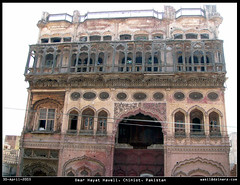Umar Hayat Haveli
Originally uploaded by wasil
Members of shaikh family migrated from Calcutta to Chiniot in the 18th or 19th century A.D. Sheikh Omar Hayat who was a successful trader born in a middle class family. He decided to construct a magnificent palace for his newborn son in 1923.Originally uploaded by wasil
Syed Hassan Shah was assigned the task of palace's construction. He gathered many famous artisans from different places who continued working day and night for 10 ten years. Rahim Bakhsh Pirjha and Elahi Bakhsh Pirjha who were masters in manabat kari did wood carving. Gazeteer Vol XXXII, Jhang district 1929 states, "The house built by Sheikh Omar Hayat is a sort of local wonder, as it cost more than Rs 200,000 to make and rises high above all other buildings of area". The construction of the palace completed in 1935 and Mr Hayat expired in same year just a couple of months before its completion.
History claims that Mr Hayat's only son Gulzar Muhammad's marriage in 1938 brought an ironic twist of fate in the shape of death . He (Gulzar) was found dead in the palace the very next day of his marriage. The news of son’s death lofted loads of grief on mother who died remembering him. Both the mother and the son were buried in the courtyard of the ground floor of the palace.
Mr Hayat's relatives left the palace thinking it as a subject to bad luck, while servants continued living for a couple of years and then parted from it. An orphanage was established by some religious leaders and then it was evacued when its top story collapsed. Next came the Qabza groups who got shops and houses constructed on the piece of land lying next to it.



1 comment:
Thank you for the pictures & the historical information!
Post a Comment